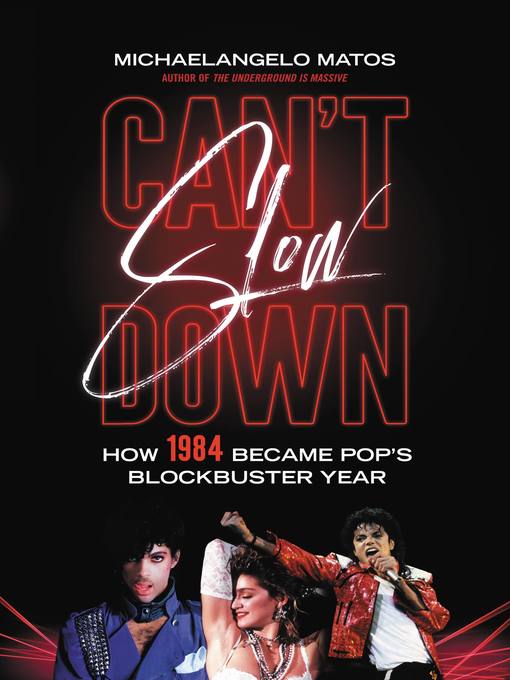
Can't Slow Down
How 1984 Became Pop's Blockbuster Year
فرمت کتاب
ebook
تاریخ انتشار
2020
نویسنده
Michaelangelo Matosناشر
Hachette Booksشابک
9780306903359
کتاب های مرتبط
- اطلاعات
- نقد و بررسی
- دیدگاه کاربران
نقد و بررسی

November 20, 2020
With this unapologetic celebration of 1980s popular music, Matos (The Underground Is Massive) hopes to correct music journalism's lopsided tendency to examine genres in opposition to the mainstream (such as punk and indie rock) while dismissing the music of the masses. Through extensive archival research, the author argues that 1984 was a banner year for pop music both commercially and artistically as radio format changes, MTV's influence, and new technology such as the compact disc promised innovation and profits. Matos organizes his narrative through a time line of industry events, including the Grammy Awards ceremony and the Jacksons' Victory tour, that crescendos with the 1985 Live Aid telecast, an international fundraising event that is hilariously recounted here, mullets and all. Matos's strength is the zippy artist profiles of everyone from Culture Club to Van Halen that zero in on the varied facets of the pop world. VERDICT Protracted dissections of events such as the Grammys may prove tedious, but pop fans with an appetite for nostalgia will find much to like.--Amanda Westfall, Emmet O'Neal P.L., Mountain Brook, AL
Copyright 2020 Library Journal, LLC Used with permission.

December 1, 2020
A close study of the artists and economics that made 1984 a monster year for music. The year overflowed with chart-topping talent--Bruce Springsteen, Prince, Madonna, Van Halen, and more were at or near their creative and commercial peaks--but veteran critic Matos avoids gooey rhapsodizing about big-name performers, instead honoring their musical brilliance while also exploring the market mechanics that undergirded their success. The watchword of the year was crossover, as rock radio lost listeners and MTV disrupted genre definitions. That allowed Van Halen's "Jump" to shift the boundaries of both pop and metal, British dance acts like Duran Duran and Culture Club to gain prominence, hip-hop groups like Run-D.M.C. to elbow into the R&B and rock consciousness, and Lionel Richie to own the pop, soft-rock, and country markets. The author organizes the period around signature events, like the launch of the Jacksons' much-hyped (and price-gouging) Victory tour, a Supreme Court ruling on home taping, the movie premiere of Prince's Purple Rain, and the recording of the for-better-or-for-worse pioneering charity single "Do They Know It's Christmas?" But Matos ranges widely within those confines and writes authoritatively and entertainingly about a host of genres, whether it's R.E.M. and H�sker D� presaging the 1990s alternative explosion, the rising visibility of global artists like King Sunny Ad� and Rub�n Blades, or country acts like the Judds angling for chart dominance. That diversification cleared a path for future corporate sponsorships and genre fragmentation, but at the time it felt like unity: Matos cheats a bit by concluding with 1985's Live Aid concerts, but no moment better exemplified how the era's breadth of artists captured the world's attention. It was a big event for a good cause and a last hurrah for a singular cultural phenomenon. A savvy, effervescent, and definitive document of a pivotal time in pop.
COPYRIGHT(2020) Kirkus Reviews, ALL RIGHTS RESERVED.

December 4, 2020
It was the year of Michael Jackson's Thriller, Bruce Springsteen's Born in the USA, and Prince's Purple Rain as well as the year of the so-called Second British Invasion, with new releases from the Police, Duran Duran, the Eurythmics, and Big Country. Matos calls 1984 "the most jam-packed pop radio year since the mid-sixties." It could be said that the mammoth success of Thriller spoiled the music industry by becoming a "tentpole" album that spun off hit after hit, becoming, Matos writes, ""the music business's standard operating procedure." Until it wasn't. Nineteen-eighty-four also brought technological changes as cassettes outsold LPs for the first time, and the first CD was manufactured in the US. Drawn from a wealth of archival material, including oral history transcripts, books, and magazines, Matos' in-depth look encompasses that landmark year's hits, stars, and trends and the cultural, social, and financial conditions that helped change the face of popular music. This robust volume provides an abundance of material here for music fans, especially those fascinated by 1980s pop culture, to savor.
COPYRIGHT(2020) Booklist, ALL RIGHTS RESERVED.

























دیدگاه کاربران